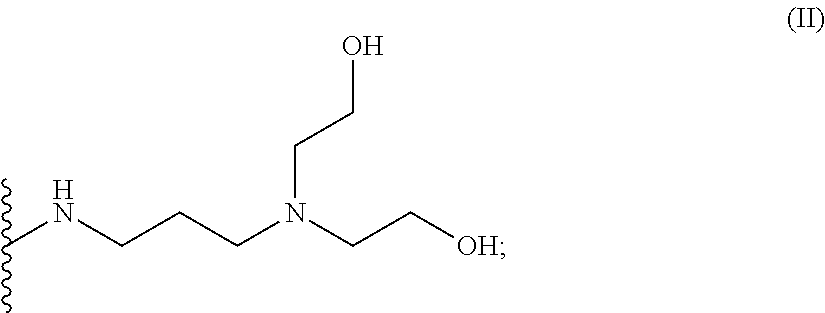Optical brighteners and compositions comprising the same
a technology of optical brighteners and compositions, applied in the direction of sulfur dyes, methine/polymethine dyes, detergent dyes, etc., can solve the problems of no improvement in the whiteness index of optical brighteners, commercially available optical brighteners are not effectively deposited on polyester-based fabrics, and the availability of optical brighteners is difficult to achieve effective deposited on certain substrates
- Summary
- Abstract
- Description
- Claims
- Application Information
AI Technical Summary
Benefits of technology
Problems solved by technology
Method used
Image
Examples
example 1
[0164]This example sets forth the structure of several compounds according to the invention. The compounds can be synthesized by the methods described above in the description.
TABLE 1Structures of several compounds according to the invention (Samples 1-10).SampleStructureSample 1Sample 2Sample 3Sample 4Sample 5Sample 6Sample 7Sample 8Sample 9Sample 10Comparative Sample 1
[0165]Comparative Sample 1 is a commercially available optical brightener. Several of the compounds set forth in Table 1 were subjected to tests to assess their ability to improve the CIE Whiteness of fabrics and to deposit on fabrics. These tests are set forth below.
example 2
[0166]This example demonstrates the change in whiteness index that can be achieved by treating fabrics (e.g., cotton fabrics) with a compound according to the invention.
[0167]Samples of 100% Cotton Style 437W (Bleached) Fabrics (Lot 5063) were pretreated with AATCC standard heavy duty liquid (HDL) laundry detergent which was free of optical brighteners. The samples were pretreated by washing with the HDL three times in a standard wash and dry procedure.
[0168]Next, a one liter wash bath was prepared containing 2.5% of the AATCC standard HDL laundry detergent, which was free of optical brighteners, and added to a tergotometer. The desired amount of optical brightener, provided in the form of a 0.1% solution of optical brightener in an appropriate solvent (e.g., methanol or DMSO), was then added to the wash water. Samples of the pretreated cotton fabric described above were then added to the tergotometer in an amount sufficient to yield a liquor ratio of about 25 (e.g., about 40 g of f...
example 3
[0171]This example demonstrates the ability of certain compounds according to the invention to deposit onto polyester-based fabrics.
[0172]Polyester-based fabrics were washed in accordance with the general procedure set forth in Example 2. Prior to adding the fabric to the tergotometer, a sample of the wash water was taken and kept so that the initial concentration of the optical brightener compound in the wash water could be determined. After the fabrics had been washed as described above, another sample of the wash water was taken and kept so that the final concentration of the optical brightener compound in the wash water could be determined. The difference in the concentration before and after washing was used to determine the amount of the optical brightener compound that was deposited onto the polyester fabric. The deposition efficiency, which is reported as the percent of optical brightener compound deposited, is reported in Table 3 below.
TABLE 3Deposition efficiency of compou...
PUM
| Property | Measurement | Unit |
|---|---|---|
| particle size | aaaaa | aaaaa |
| particle size | aaaaa | aaaaa |
| structure | aaaaa | aaaaa |
Abstract
Description
Claims
Application Information
 Login to View More
Login to View More - R&D
- Intellectual Property
- Life Sciences
- Materials
- Tech Scout
- Unparalleled Data Quality
- Higher Quality Content
- 60% Fewer Hallucinations
Browse by: Latest US Patents, China's latest patents, Technical Efficacy Thesaurus, Application Domain, Technology Topic, Popular Technical Reports.
© 2025 PatSnap. All rights reserved.Legal|Privacy policy|Modern Slavery Act Transparency Statement|Sitemap|About US| Contact US: help@patsnap.com



